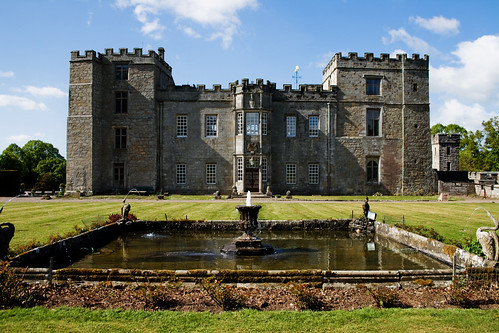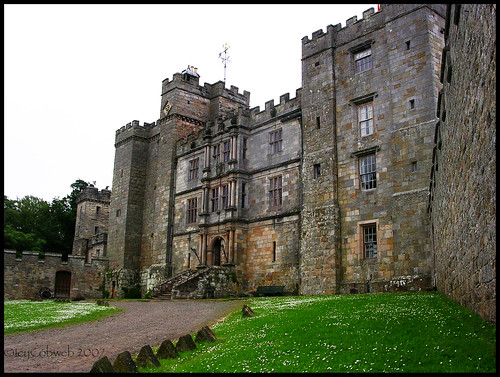Chillingham Castle stands in Northumberland, some 14 miles north of Alnwick. It dates back to the tumultuous days of the 12th century. Even Edward I, Hammer of the Scots, stayed here on his journey north in 1298.
The castle boasts a dungeon beneath the northeastern tower. A rack, an iron maiden and various other implements lie awaiting the unsuspecting visitor.
But what castle with a dungeon could avoid having ghosts and legends attached to its name? Following our introduction to Green Lady ghosts last week, this week we’ll meet blue, grey, and white ghosts…
The Blue Boy of Chillingham Castle
Perhaps Chillingham Castle’s best-known phantom is the Blue Boy, despite the fact he disappeared in the 1920s.
According to legend, the Blue Boy made his appearances at the strike of midnight in one of the rooms not open to the public.

The reports claim the sounds of a child in pain accompanied his appearances. The noises always came from the wall.
The cries died away and a bright light would form near the bed. This halo gave him his alternative name, the Radiant Boy.
Some guests at the castle described seeing a young boy dressed in blue. The witnesses placed his clothes as dating to the 1660s.
In the 1920s, workmen cut a passage into the tower rooms on the other side. They unearthed the bones of a young boy in the wall. Fragments of blue fabric lay beside the skeleton.
The remains were buried in the Church. The Blue Boy seems to have disappeared…although some report seeing a blue flashing halo in the small hours.
Witnesses have seen the flashing from the courtyard and nearly always attribute it to faulty lights – though Sir Humphrey is quick to point out no wiring runs through that part of the wall.

The Grey Lady
Continuing the tradition of ghosts with colourful names is the Grey Lady. Lady Mary Berkeley’s husband, Lord Grey of Wark and Chillingham, abandoned her for her sister, Henrietta.
Lord Grey seemed to make desertion a habit. He also deserted the Duke of Monmouth, despite the fact he’d backed him in an attempt to wrest the crown from James II!
Lord Grey actually stood trial in 1682 for seducing Henrietta.
Lady Mary died in 1719. Perhaps her only triumph was outliving her feckless husband. He died in 1701, and her faithless sister died in 1710.

What is a Silky?
Tales of these spirits are specific to the Anglo-Scottish border region. In some tales, they tidy and clean around the house. Other Silkies are mischievous, playing pranks on their human housemates.
The Grey Lady of Newcastle’s Assembly Rooms is an example of the third type of Silky. Here, a sad spirit haunts the location of her demise. The rustle of her silk gown gives away her presence. Lady Mary seems to fall into this category.
The tales all point out that she had only her daughter for company in the castle. Did Lady Mary have to run the household herself?
Most stories describe Lady Mary wandering the halls in search of her husband. Witnesses who hear the rustling also describe an unearthly chill as she passes.
Some of the stories mention a female ghost leaving a painting and walking around the castle. The authors seem to think this may be the Grey Lady herself.
The Lady in White
Those in the castle also report a figure in white in the pantry. One tale dates to the time when the room held the family silver. A footman slept in the room as a security measure.
One night, a woman in white appeared inside the room and begged him for water. He turned away to fetch some because she seemed so wretched. It was only then that he realised the door was locked.
If he hadn’t opened the door, then how had she gotten inside?

According to the legend, she still begs for water. No one knows who she is, but some suspect she was poisoned.
In ghost stories, the White Lady seems to refer to loss. In the medieval period, the White Lady acted as a death omen. If you saw one, a member of the family would die soon.
In the UK, variations on the tale imply a ghost becomes a White Lady if the individual was murdered or commits suicide. If a woman knows the location of treasure but hasn’t told anyone, she’ll become a White Lady when she dies. She’ll keep appearing to people until someone goes with her and finds the treasure.
Based on that, the White Lady at Chillingham could well have been murdered…
That’s not all…
The castle has other ghosts beyond these three colourful figures.

The voices of two men sometimes erupt in the chapel. No one can follow their conversation because they stop talking if anyone listens too hard.
Others claim to have seen phantom monks in the grounds or sense malevolent presences.
It’s hardly surprising, given the blood-soaked history of the place!
Whether it’s haunted or not, Chillingham Castle is well worth a visit. It’s a fascinating ‘work in progress’ as the owners restore it to its former glory.
A dolls’ house in their museum inspired my short story, Left, which you can find in my free short story collection, Checkmate: Tales of Speculation Fiction.
Chillingham Castle is open from 12 pm until 5 pm, until 4th November 2018. But you can also stay there in their self-catering accommodation!
Who knows which ghosts you might see?
Nutty about folklore and want more?
Add your email below and get these posts in your inbox every week.
You'll also get my 5-step guide to protecting your home using folklore!







I downloaded a copy of Checkmate. Thanks for sharing the link. Can’t wait to read it!
This castle sounds like an episode of the game “Clue.”
Ooh it does!